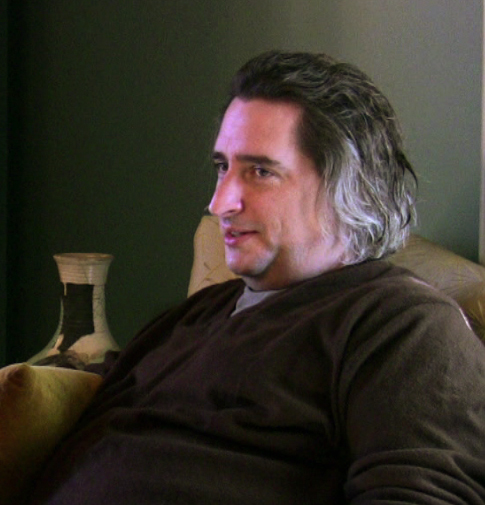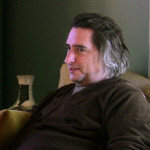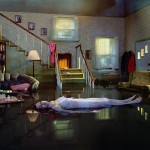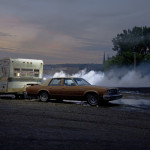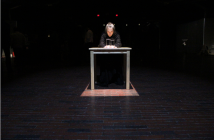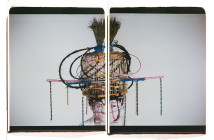A CONVERSATION WITH GREGORY CREWDSON
Gregory Crewdson is a photographer known best for his high production photographic projects, Hover, Twilight, and Beneath the Roses, open ended narratives that blend the suburban vernacular of the Northeast with the paranormal. Other photographic projects include Fireflies, where the insects are rendered in black and white long exposures as abstract light sources, and Natural Wonder, dioramas of taxidermy animals within ambiguous storylines. A longtime educator, Crewdson is the head of the graduate photography program at the Yale University School of Art.
Big Red writer Ben R. Sloat interviewed the noted photographer the day after his lecture at MassArt in late October.
----
Ben R. Sloat: I was fascinated with how you, in your talk yesterday, see yourself in the strain of photographers like Walker Evans, Eggleston and Friedlander - who all seem to be in the business of making American myth. I wonder if you see that as being true for you as well or are you developing storylines of sites they might have photographed and moved on from?
Gregory Crewdson: I think you’re right on in terms of option number one. I respond to those photographers and others as artists who have reinvented the iconography of the American landscape, and in doing so, they create a myth, or a fiction. When I mentioned these photographers, often there is a certain kind of confusion, because they (viewers) don’t see how my pictures relate to that tradition of documentary photography. I don’t think I make those distinctions between fiction and documentary photography. In the end all photographs are subjective constructs, and they’re powerful because they all suggest a vision of the world.
So there’s a kind of continuity from Walker Evans’ vision of America extending to Robert Frank's. Lee Friedlander extended that, taking shared iconography and moving it forward, dramatically shifting that language in a new way.
BRS: In a certain sense, if we look at Eggleston’s work, we’re not learning about location, we’re learning about his perspective, his vision of a place. Do you see yourself doing that? Also, why have you chosen this specific region to work?
GC: I feel very aligned in some way with Eggleston, maybe first and foremost he’s one of the reasons why I’m a photographer. His pictures really shaped my perspective, but also his strongest work is concerned with place, with geography. But again, it’s his own view of landscape. I feel like, in a sense, that’s what I’ve done.
Why do I photography where I do? That’s a good question. I’m not even sure at this point. There are rational reasons, then there are irrational reasons. The most basic reason, as I mentioned last night, is that my father founded this property in the Berkshires, and we had a cabin there. We spent the summers there. There’s a connection to my father there, my family, my childhood. The landscape has a combination of being connected to it and not being connected to it that I’ve responded so much to.
There’s more practical reasons where, because of the nature of my work, you really have to be a known enterprise to make the pictures that I make. So the fact that I’ve been coming back and making these pictures over a number of years allows a certain kind of trust.
Then there are the less noble reasons, that’s maybe what’s most interesting, those are much more difficult to define. All I know is that when I go there, my synapses start firing, my imagination opens up in a way that it doesn’t in other places.
BRS: Part of that might be in removing yourself from a familiar landscape where you are living in New York City. Is that journey, that travel, removing from the everyday, a main part of that?
GC: I always say I’ve created two lives for myself in a way. I have a very happy family life with two children. But the way I make pictures, at the core it’s a bit of a lonely enterprise even though there’s so many people involved. The whole process of me going up there, staying there, location scouting, getting into the world of the pictures, going for a run in the mornings…all that is part of the process, the invisible process that’s very important to me.
BRS: Light seems to be a major character in your work, a central element that compels the human characters in your photographs. In your “Fireflies” series, you’ve mentioned how these insects use light to communicate desire. I wonder how you see the craft of light as a language in your work.
GC: First and foremost, I think photography is concerned with light. On the most fundamental level it’s an interaction of light and film. For me, light has become a central way of storytelling. If you look at almost any one of my pictures, the light sort of defines the story in one way or another. That’s become increasingly important, using light as meaning, at the core level. That’s true of the pictures from Beneath The Roses, also true for the Fireflies, in the most elemental way. Those pictures, on the surface, might appear to almost work in opposition to the productions I’m most known for. Really, at the core, there’s something similar about telling a story through light.
BRS: I’m interested in the imposition of the artifice in relation to nature. In this way, do you see yourself in relation to the work of the New Topographics photographers, who were often dealing with the encroachment of communities into nature?
GC: I’m a huge fan of the New Topographic work, I think they’re under-acknowledged generally in terms of its influence on contemporary art. I always thought it was interesting that, in the 70s, there seemed to be two very defined tracks of landscape photography. On the one hand, there was the New Topographic work, which were in black and white had a neutral, objective stance. On the other hand, there was Joel Sternfeld and Stephen Shore and others who used color photography in a more luminous way. It seemed like both fields of New Topographic work was harking back to a 19th century view of photography, like Timothy O'Sullivan. The color photographers of (the group) were inspired by luminous painting.
I think those two, almost oppositions in approach, define so much the next generations of artists who are shaped and inspired by them. I’m most directly influenced by photographers like Joel Sternfeld. I remember when I saw his American Prospects photographs in the late 70s, I was so excited by the work that I took an internship at Daniel Wolf Gallery, where he showed, just to meet him. Then I met him through that, he was showing part of that work then, we’ve maintained a friendship ever since. He was very influential in my work.
BRS: I was thinking about that, and I brought one of his photos (“Renegade Exhausted Elephant”) with that boxy car in the front with the door open, thinking, “Gregory Crewdson must love that car!”
GC: I love that car! I love that Stephen Shore photograph of cars! I’m actually doing a conversation with the both of them at Yale in a few weeks together, but it’s funny because I think their work has shaped my work in so many ways, but those cars have become iconic. I use them partially because they were in their pictures, but now I really have to go find them because they barely exist.
BRS: I’m also interested in the visual language of cinema that you use. It seems that the audience has an increased sophistication with that cinematic language. Do you think that helps them understand the parameters of your work?
GC: I think cinema, or movies in general, are the sublime of our time. Photographs are kind of the common currency of our culture. Film has that esteemed, almost spiritual dimension of a collective dream. I think we all respond to film on some subliminal level. I always thought film was so beautiful because it’s a mirage, it’s light on a screen and it doesn’t exist. That’s part of its power.
For me, I just love looking at film, I love looking at light in film. That sort of transcendent quality, I do think that it’s interesting that obviously my photographs have a direct link to cinematic language, but at the same I’ve always said that every way my pictures are like a movie, there are also ways they’re also not like a movie. For me the way they’re not like a movie is more defining.
BRS: The inferred narrative that the viewer has to impose is a difference, but the major difference is the magical quality of the photograph to suspend time, suspend the narrative.
GC: It’s interesting- now, almost everyone who works on my pictures comes out of movies. They’re all, one way or another, moviemakers: grips, electrics, etc. I think they all really like working on my pictures because of the ways it’s not like their ordinary practice. We’re all kind of invested in trying to capture a perfect moment. They’re so used to having to compromise, to shoot coverage, to shoot this many scenes in a day. There’s something gratifying, in a way, that we’re all working towards creating one moment: we’re either going to get it or we’re not going to get it. That’s a real privilege, to be able to work in that way.
BRS: You defined your role in New York with your family, then a photographer going out and shooting. How does your role as a teacher fit into all this?
GC: Teaching obviously is really important to me. I don’t really make a distinction between being an artist and being a teacher, I think they’re part of the same thing. I think it’s more difficult to balance, with children, with travel, fortunately the administration gives me allowances to take time off when I need it.
Right now, I’m very embroiled in it because I’m running the program for the semester. I love that, because you might know, the program’s very small, 16 students. We have great people coming in and out of the program. The main reason I teach, I think it’s always so important to keep in touch with the next generation of artists, to see what they’re thinking about, that’s one thing. Also, I see it as a privileged forum, like in critiques, you can really talk about pictures in a direct way.
BRS: Is there a philosophy behind your teaching? The Yale program is famously rigorous.
GC: I guess the philosophy for me is that I’m interested in pictures, how pictures operate as groups of photographs, defining a kind of world vision. I tend not to talk about technique, technical aspects, I certainly avoid making any references to my own work, consciously. If I have a kind of bias, it would be towards pictures as describing the stories being told, I’m always interested in how photography makes connections to other things. Photography effortlessly connects to movies, or to literature, or to advertising, or television, or the internet. I like to make those connections, to bring those out.
BRS: You spoke yesterday about being a grad student and making work. I admired the bravado to knock on people’s doors, activate the community, get them to participate in your work. Photographers might be considered to be voyeurs, on some level, but here you were, consciously interacting. Also, I’m curious as to why you think they wanted to be in the photographs?
GC: There’s a few questions there. First, there’s a sort of youthful arrogance, when you’re a certain age and you do feel empowered to just make these pictures out of whatever cost of humiliation or whatever. I don’t feel that so much anymore, it’s funny - I’m much more weirdly passive now. I’ll make a decision about a picture and then this whole enterprise starts, but I’m not involved on that sort of level anymore.
I think those pictures are still quite voyeuristic in any case, that’s sort of where the tension is. People always want to be paid attention to. That’s a constant. That remains the case in my pictures now. People wonder “how do they put up with us taking over a whole street, closing it down for traffic?” It’s because there’s interest there, that’s a human trait. I think that operates on so many different levels.
That’s why reality TV is so prevalent in our day to day culture, or what you see on the internet, on Youtube. People just want their story told, in one way or another.
BRS: I’m interested in your use of taxidermy: the birds, the bears. I wonder if you see a relationship between the simulation of taxidermy and of photography.
GC: Yes, one of the reasons I was so struck early on by the museum dioramas is that there is an attempt, like a photograph, to immortalize life. To freeze life in a way, to stop time. Of course, in the end, photography and taxidermy and museum dioramas really speak to the impossibility of doing so. One of the reasons that museum dioramas are so fascinating is because they’re ultimately so sad, in a way. Because it’s so stilted, because how much you attempt to hold onto something, that attempt to do so fails. There’s something very beautiful about that too. I think photography is the same. Photography in its most common use is about an attempt to preserve something, to immortalize a moment. That’s why family snapshots, family pictures show that need to capture a moment in your life, define it as being important and happy. But when you look back on the pictures they feel so sad, because life goes on.
- Gregory Crewdson in conversation with Ben Sloat in October
- Gregory Crewdson, Untitled (Ophelia), chromogenic print, 2001 (from the series “Twilight”)
- Gregory Crewdson, Production Still (Edie in the Trailer), inkjet print, 2007 (form the series “Beneath the Roses”)
All images are courtesy of the artist, Gagosian Gallery, and White Cube.

